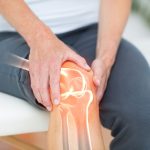Endometriosis: A Naturopathic Case Study
Tolle Causam
April Blake, ND, LM
Last fall I received a patient referral from a local acupuncturist – a 45-year-old woman named Jennifer who was suffering from episodes of severe abdominal pain, anxiety, insomnia, and dyspareunia. I arranged for a free, 30-minute consultation with Jennifer to assess whether or not I could help her. She explained that she was experiencing episodes of severe abdominal pain that she described as being “frozen with pain,” where she couldn’t move and would have to take slow, shallow breaths for an entire day, along with experiencing severe nausea. These episodes would occur on Day 1 of her menses or the day before that. The last 2 episodes were felt in her upper back, but the previous episodes were felt in her abdomen as if someone was “punching her in the stomach.”
These episodes had been occurring for the past 2 years; during the first year she experienced 2 episodes, and during the second year she experienced 4 episodes. Since they were increasing in frequency, she was feeling increasingly anxious about her health, as she was unable to work and/or care for her family during these episodes. Over the past 2 years, she had worked with her primary care provider to assess the cause of the episodes via abdominal ultrasound, abdominal CT, abdominal MRI, pelvic MRI, stool, urine, and blood testing. All tests were normal. She had also been evaluated by a gastroenterologist, who performed an endoscopy and colonoscopy. The colonoscopy revealed a benign polyp and diverticulosis in 3 areas of the colon. A gynecological evaluation was normal, with the exception that pain was felt on pelvic exam and a small (1 cm) endometrioma on her right ovary was found during a transvaginal ultrasound. Most recently, she had been working with an acupuncturist but hadn’t seen much improvement. This led her to seek out naturopathic medicine.
Given the information that Jennifer provided, I felt that her symptoms indicated endometriosis, as well as an imbalance in her microbiome and estrobolome, ie, that portion of the microbiome that metabolizes estrogen. Indeed, her clinical picture, symptomology, and imaging studies had revealed this to be the case. I had seen dozens of similar cases and had successfully treated them with naturopathic medicine. I recommended that Jennifer begin by coming in for weekly sessions using an FDA-approved mat that combines far infrared light therapy with negative ion technology. Besides helping to reduce inflammation in her body, these sessions would also give her an opportunity to have dedicated time to relax and meditate. I also recommended monthly meetings with me over the next 6 months so that I could track her cycles carefully and assess how her body responded to the therapies we used. As she was very eager to get relief from her symptoms, Jennifer agreed to the proposed treatment schedule and scheduled her first appointment to begin the same day as our consultation.
Pathogenesis of Endometriosis
Endometriosis occurs when endometrial cells move beyond the uterus, proliferate, and stimulate an inflammatory response.1 Its pathogenesis is thought to be multifactorial, including altered immune function, ectopic endometrial tissue, abnormal endocrine signaling, and genetic influences. Sampson’s theory of retrograde menstruation is the most commonly proposed mechanism of action for endometriosis. According to the theory, during menses, endometrial cells travel in reverse through the fallopian tubes and enter the peritoneal cavity.2 Although up to 90% of women are thought to have retrograde menstruation, most of them do not develop endometriosis.3
Diagnosis
Definitive diagnosis of endometriosis is made via histologic examination of a surgically biopsied lesion (usually during laparoscopy). Visual confirmation of endometriosis without biopsy, while helpful, is of limited value by itself because surgeons’ expertise is so variable.4 Nonsurgical diagnosis may include: detection of ovarian endometrioma on ultrasound; biopsy and cystoscopic evaluation of detrusor lesions; visual observation of the posterior vaginal fornix and biopsy of rectovaginal lesions; and detection of rectovaginal endometriosis on physical exam that is confirmed on imaging. Again, while a definitive diagnosis of endometriosis requires tissue biopsy with histologic confirmation, a presumptive diagnosis of the disease may be based on a combination of symptoms, signs, and imaging findings.
Patient Presentation & History
Jennifer reported that she had experienced severe menstrual cramping, heavy bleeding with menses, and nausea with occasional vomiting during most menstrual cycles since menarche at 13 years old. She began oral contraceptives in order to get relief from these symptoms at 18 years old, and continued to use them until she wanted to become pregnant, at 36 years old. She was unable to conceive for 4 years until she received intrauterine insemination, which was successful. During the 4 years that she was off oral contraceptives, she experienced severe acne as well as dysmenorrhea. She underwent an elective caesarean section, and recovered well. A year after giving birth, she reported that her abdomen became diffusely tender with pressure. She also began experiencing 1-2 days of exhaustion so severe that she was unable to leave her bed and would sleep throughout the day.
In addition to Jennifer’s diffusely tender abdomen and bouts of severe fatigue, she developed anxiety after the birth of her son such that she was unable to fly, felt overwhelmed in crowds (causing her to always stand or sit near the exit), and was constantly worried about her son’s well-being, even though her son was very healthy.
Jennifer reported that since the birth of her son 6 years ago, her cycle had occurred every 22 days and typically involved very heavy flow and cramping.
Jennifer had been under severe stress for the past 2 years, supporting her partner during cancer, caring for her son during the day, and working as a bookkeeper during the evenings until 1 AM, Monday through Friday. She reported that her work was stressful as well, due to the amount of work she took on “in order to make enough money to live in the Bay Area.” Her diet consisted of a cup of coffee in the morning, followed by salad for lunch, and then vegetables and protein – typically chicken or beef – for dinner. Jennifer had experienced some improvement while avoiding gluten, and thus for the most part was following a gluten-free diet. She reported having a sweet tooth and would typically have cookies for dessert after dinner, lollipops during the day, and candy when she was tired.
Her sleep had become disrupted during the 2 weeks prior to our meeting, where she was having trouble falling asleep as well as staying asleep.
Her family history was significant in that her mother had breast cancer at 70 years old and a paternal aunt had suffered severe endometriosis.
Initial Work-up & Treatment
My initial work-up consisted of completing a dried urine panel of comprehensive hormones, a comprehensive stool test, and blood work that included a CMP; CBC with platelets and differential; ferritin; thyroid tests (TSH, free T3 and T4, and thyroid antibodies); whole-blood mercury and lead; an Epstein-Barr virus panel (IgM and IgG titers); amylase; vitamin B12; and 25-hydroxyvitamin D. I recommended that she begin eating a diet that consisted of no less than 3 meals per day. Each meal should contain 20-25 grams protein per meal to support healthy neurotransmitter production (to alleviate her anxiety and insomnia); low-carbohydrate vegetables, including over 4 cups/day emphasizing green vegetables to encourage a healthy microbiome; healthy fats, such as avocados, nuts, seeds and extra virgin olive oil; and whole-carbohydrate foods such as fruit, beans, potatoes, and squash. I also advised her to avoid refined carbohydrates including refined sugars.
In addition, I recommended she begin a multi-vitamin, 2000 mg/d evening primrose oil, and an overnight infusion of dried stinging nettle leaf to support healthy hormone levels. I also recommended that she increase mineral intake and take 50 mg of 5-hydroxytryptophan (5-HTP) with lunch and dinner in order to increase serotonin levels and reduce anxiety.
Follow-up Visits
Three Weeks Later
Three weeks later, Jennifer followed up in my office. She reported that her energy had improved and that she had not experienced “crashing” due to fatigue during the previous month, but that she had experienced abdominal pain around ovulation as well as increased sugar cravings the week leading up to her menses.
Her significant lab findings included an active infection with Epstein-Barr virus, a low-normal ferritin level of 55 ng/mL (RR=15-150), and positive anti-thyroglobulin antibody levels (but otherwise-normal thyroid function results).
Given her symptoms and lab results, I recommend adding the following: 1000 mg of L-glutamine with breakfast and dinner in order to reduce refined sugar cravings; 500 mg of monolaurin for anti-viral support; 1000 mg curcumin 1 hour away from food in order to reduce inflammation within the body; and the nightly application of a castor oil pack over her liver for 20-30 minutes to improve clearance of toxins and promote healthy levels of hormones. We also reviewed the importance of a diet consisting of a rainbow of colors for immune system support, especially by increasing her intake of fruits and vegetables.
Three Weeks Later
Three weeks later, Jennifer followed up, reporting that her energy had remained stable, she had not experienced abdominal pain prior to onset of her menses, but that her day-long anxiety had continued and that her cravings for sugar had remained high. Her cycle length was now 26 days instead of 22 days.
At this time I recommended increasing her 5-HTP dose from 50 mg with lunch and dinner to 100 mg with breakfast, lunch, and dinner. I also suggested increasing her L-glutamine from 1000 mg with breakfast and dinner to 1000 mg with breakfast, lunch, and dinner; and I added 100 mg GABA, to be taken upon rising and at mid-AM and mid-PM.
One Month Later
Four weeks later, Jennifer reported a 28-day cycle and was shocked that the supplements were having a positive effect on her hormones as well as her mood. She said she was feeling calmer during her day and that her sugar cravings had decreased. She was continuing to experience dysmenorrhea, however.
Jennifer’s stool results were significant for the presence of the following: Helicobacter pylori, Blastocystis hominis, Bacillus, and Pseudomonas. They also revealed elevated secretory IgA, anti-gliadin antibodies, and calprotectin levels.
Given these findings in combination with Jennifer’s clinical presentation, I recommended treating the GI bacterial infections, and we reviewed the standard of care for treating H pylori according to allopathic medicine vs naturopathic care. Jennifer requested naturopathic care, which consisted of a strict gluten-free diet; 0.5 mg melatonin 1 hour prior to bedtime in order to strengthen the tone of her lower esophageal sphincter5,6; nitazoxinide, 500 mg twice/day with food for 3 days for the treatment of Blastocystis hominis; followed by treatment for H pylori infection and Bacillus and Pseudomonas overgrowth: 500 mg Uncaria tomentosa (cat’s claw) 3 times/day X 10 days, then 500 mg/day X 3 wks, 500 mg Pistacia lentiscus (mastic gum) twice daily between meals X 28 days, and 1000 mg D-limonene every other day X 20 days.
One Month Later
Four weeks later, Jennifer reported that she tolerated the treatments well overall but that her cycle was 21 days the previous month.
Jennifer’s urinary hormone results were reported and were significant for elevated estradiol, low progesterone, elevated AM + noon cortisol, and elevated total cortisone.
Based on these results I recommended adding 225 mg Vitex agnus-castus (chasteberry) extract twice daily to increase progesterone levels, and 125 mg diindolylmethane (DIM) twice daily to promote healthy estrogen metabolism.
Over the course of our next 2 meetings (once per month), Jennifer continued to improve, her cycle length continued to be 28 days, her mood, energy and sleep had improved overall, and she had reduced her level of work in order to support her health. She continues to enhance her health with a healthy diet, supplements, meditation, and exercise.
Closing Comments
In summary, Jennifer was suffering from endometriosis as well as gastrointestinal infections, a viral infection and an autoimmune process, all of which naturopathic medicine addresses holistically and successfully. As readers are aware, naturopathic medicine offers a wider lens through which to view and treat women’s health that has been historically treated by allopathic medicine using treatments that typically include hormones and anti-inflammatories that often ignore the cause of the disease process. My hope is that we continue to learn how to bridge the 2 worlds of medicine so that more people can gain access to both addressing the cause and accessing therapies needed for the body to regain balance.
References:
1. Giudice LC. Clinical practice. Endometriosis. N Engl J Med. 2010;362(25):2389-2398.
2. Sampson JA. Peritoneal endometriosis due to the menstrual dissemination of endometrial tissue into the peritoneal cavity. Am J Obstet Gynecol. 1927;14(4):422-469.
3. Halme J, Hammond MG, Hulka JF, et al. Retrograde menstruation in healthy women and in patients with endometriosis. Obstet Gynecol. 1984;64(2):151-154.
4. Dunselman GA, Vermeulen N, Becker C, et al. ESHRE guideline: management of women with endometriosis. Hum Reprod. 2014;29(3):400-412.
5. de Oliveira Torres JD, de Souza Pereira R. Which is the best choice for gastroesophageal disorders: Melatonin or proton pump inhibitors? World J Gastrointest Pharmacol Ther. 2010;1(5):102-106.
6. Kandil TS, Mousa AA, El-Gendy AA, Abbas AM. The potential therapeutic effect of melatonin in Gastro-Esophageal Reflux Disease. BMC Gastroenterol. 2010;10:7.
 April Blake ND, LM, is a naturopathic doctor, licensed midwife, and owner of Solstice Integrative Medicine, a collaborative medical clinic of integrative providers in San Rafael, CA. Dr Blake graduated from Bastyr University in 2007 and maintains a practice focusing on what she calls the “3 Ms: Menopause, Mood and Mystery Illnesses,” using herbal medicine, nutrition, vitamins, minerals, homeopathy, amino acid therapies, hormone replacement, and infrared therapy. In her free time, she enjoys spending time with her 2 children and husband baking gluten-free treats, hiking, going to the beach as much as possible and spending time on self-growth and awareness.
April Blake ND, LM, is a naturopathic doctor, licensed midwife, and owner of Solstice Integrative Medicine, a collaborative medical clinic of integrative providers in San Rafael, CA. Dr Blake graduated from Bastyr University in 2007 and maintains a practice focusing on what she calls the “3 Ms: Menopause, Mood and Mystery Illnesses,” using herbal medicine, nutrition, vitamins, minerals, homeopathy, amino acid therapies, hormone replacement, and infrared therapy. In her free time, she enjoys spending time with her 2 children and husband baking gluten-free treats, hiking, going to the beach as much as possible and spending time on self-growth and awareness.









